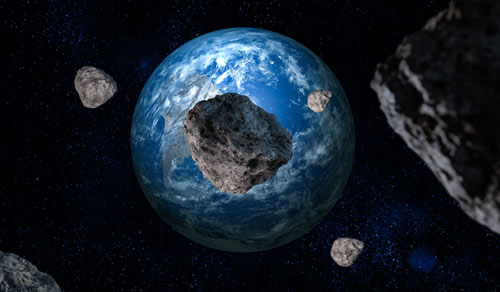
It’s not worth panicking over, but it is at least worth mentioning the “chance” that a giant asteroid could hit the planet.
Its calculated trajectory varies, with reports claiming it will arrive March 5, or between the 7th and 8th, and will hurl as close as 11,000 miles away from Earth, but that’s about as close as anything close to its size has come on record.
Lexi Morgan at Intellihub.com explains:
NASA has now updated its Jet Propulsion Laboratory’s close approach data to reflect a 22 hour window of uncertainty regarding asteroid 2013 TX68, which is currently set to nearly graze Earth.
NASA hopes the massive chunk of rock will pass safely by Earth at a distance of around 18,000 miles between the dates of Mar. 7, at 1 p.m. and Mar. 8, until 11 a.m. Eastern Time.
It’s also worthy to note that even if the asteroid safety passes the planet, it still has the potential to collide with the moon, orbiting satellites, the International Space Station or other space-based platforms.
The Sun story adds additional details:
NASA has admitted there is a chance the asteroid 2013 TX68, a 100ft-wide rock which is currently heading towards us, could impact earth.
The asteroid is due to pass earth on March 5 by as close as 11,000 miles however NASA says there is “a chance” it could actually hurtle into our planet on September 28, 2017.
But NASA puts the odds of this happening at “no more than 1-in-250-million.”
[…]
NASA has said it could be anywhere between 9 million miles and 11,000 miles. This large range is due to a wide range of possible trajectories since it was tracked for only a short time after discovery.
Though there’s only a fraction of a chance that we will be entering a doomsday scenario ripped from the pages of Hollywood in a period of just a few days from now, scientists also point out that it could wreak havoc on the moon, or satellite and man-made space infrastructure.
So, there could be noteworthy damage. Maybe.
Regardless, it is a reminder of the fragility and mortality of our condition here. There are many disturbing forces, and there is little reason to remain well adjusted to them.
Russia has just unveiled a plan to use ICBMs to blow up smaller asteroids/meteors that more frequently pelt their homeland. Chelyabinsk took an unexpected hit last year.
NASA has previously announced a nearly identical plan for United States defense against possible threats from space. The Daily Mail reported:
Dramatic proof that any of these can strike Earth came on 15 February last year, when an unknown object exploded high above Chelyabinsk, Russia, with 20 – 30 times the energy of the Hiroshima atomic bomb.
The resulting shock wave caused widespread damage and injuries, making it the largest known natural object to have entered the atmosphere since the 1908 Tunguska event, which destroyed a forest area of Siberia.
The Daily Caller reports:
The Russian government is going to revamp some of its intercontinental ballistic missiles (ICBM) in order to blow up asteroids before they reach Earth.
[…]
Apparently, the nuclear-armed ICBMs would be used to target asteroids with a 20 to 50 meter diameter (approximately 65 to 164 feet). Asteroids of these sizes are difficult to detect, and using an ICBM to take them out before they hit Earth would be the last line of defense preventing a potential catastrophe.
In an age where space has been weaponized, along with weather and climate, and foreign relations have returned to Cold War tensions, that could have layers of hidden intention as well.
“Unfortunately, we only know about roughly 1% of those asteroids that get down to the 30-meter size, so there’s a tremendous amount out there that we have yet to discover,” said Jason Kessler, NASA’s man in charge of identifying potential asteroid threats, to CNN.
Anyway, there could be surprises. Russia has certainly taken note of what could and has happened.
H/t Intellihub.
Read more:
NASA Plan to Protect Planet Hopes “Nuclear Blast Could Nudge Large Asteroid Off Course”
Is NASA Covering Up a Devastating Meteor Strike In Iran: “Destruction On An Unimaginable Scale”